Pub
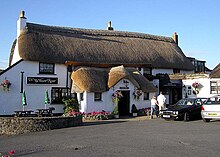

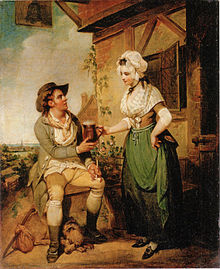
A pub (short for public house) is a
- is open to the public without membership or residency
- serves draught beer or cider without requiring food be consumed
- has at least one indoor area not laid out for meals
- allows drinks to be bought at a bar (i.e., not only table service)[2]
The history of pubs can be traced to
Although the drinks traditionally served include
A
History
Origins
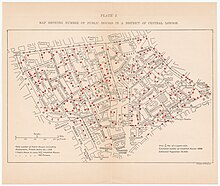
Ale was a native British drink before the arrival of the
After the departure of Roman authority in the fifth century and the fall of the Romano-British kingdoms, the Anglo-Saxons established alehouses that may have grown out of domestic dwellings, first attested in the 10th century. These alehouses quickly evolved into meeting houses for folk to socially congregate, gossip and arrange mutual help within their communities. The Wantage law code of Æthelred the Unready prescribes fines for breaching the peace at meetings held in alehouses.[10]
A traveller in the early Middle Ages could obtain overnight accommodation in monasteries, but later a demand for hostelries grew with the popularity of pilgrimages and travel. The Hostellers of London were granted guild status in 1446 and in 1514 the guild became the Worshipful Company of Innholders.[11] A survey in 1577 of drinking establishment in England and Wales for taxation purposes[12] recorded 14,202 alehouses, 1,631 inns, and 329 taverns, representing one pub for every 187 people.[13]
Inns
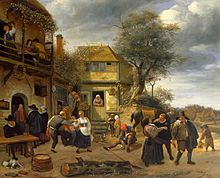
Inns are buildings where travellers can seek
In Europe, it is the provision of accommodation,[15] if anything, that now distinguishes inns from taverns, alehouses and pubs. The latter tend to provide alcohol (and, in the UK, soft drinks and often food), but less commonly accommodation. Inns tend to be older and grander establishments: historically they provided not only food and lodging, but also stabling and fodder for the traveller's horse(s) and on some roads fresh horses for the mail coach.
Famous London inns include
The original services of an inn are now also available at other establishments. Hotels, lodges, and motels focus more on lodging customers than on other services but usually provide meals. Pubs are primarily alcohol-serving establishments. Restaurants and taverns serve food and drink. In North America, the lodging aspect of the word "inn" lives on in hotel brand names like Holiday Inn, and in some state laws that refer to lodging operators as innkeepers.
The Inns of Court and Inns of Chancery in London started as ordinary inns where barristers met to do business, but became institutions of the legal profession in England and Wales.
Advent of the modern pub

Pubs as we know them today first appeared in the 19th century.[16] Before this time alehouses were largely indistinguishable from private houses and the poor standard of rural roads meant that, away from the larger towns, the only beer available was often brewed by the publican himself.[17] With the arrival of the Industrial Revolution, many areas of the United Kingdom were transformed by a surge in industrial activity and rapid population growth. There was huge demand for beer and for venues where the public could engage in social interaction, but there was also intense competition for customers.
Gin houses and palaces became increasingly popular, while the Beerhouse Act of 1830 caused a proliferation of beerhouses. By the mid-19th century, pubs were widely purpose-built so their owners could incorporate architectural features that distinguished them from private houses to make them stand out from the competition. Many existing public houses were also redeveloped at this time, borrowing features from other building types and gradually developing the characteristics that make pubs instantly recognisable today. In particular, and contrary to the intentions of the Beerhouse Act, many drew inspiration from the gin houses and palaces.
Bar counters had been an early adoption, but ornate mirrors, etched glass, polished brass fittings and lavishly tiled surfaces were all features that had first made their appearance in gin houses. Innovations such as the introduction of hand pumps (or
Tied house system
The latter half of the 19th century saw increased competition within the brewing industry and, in an attempt to secure markets for their own products, breweries began rapidly buying local pubs and directly employing publicans to run them. Although some tied houses had existed in larger British towns since the 17th century, this represented a fundamental shift in the way that many pubs were operated and the period is now widely regarded as the birth of the tied house system.[19]
Decreasing numbers of free houses and difficulties in obtaining new licences meant a continual expansion of their tied estates was the only feasible way for breweries to generate new trade. By the end of the century more than 90 per cent of public houses in England were owned by breweries and the only practical way brewers could now grow their tied estates was to turn on each other.[20] Buy-outs and amalgamations became commonplace and by the end of the 1980s there were only six large brewers left in the UK, collectively known as the Big Six; Allied, Bass, Courage, Grand Metropolitan, Scottish & Newcastle and Whitbread.[21]
In an attempt to increase the number of free houses, by forcing the big breweries to sell their tied houses, the Government introduced
Decline in Britain
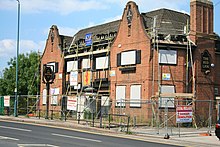
The number of pubs in the UK has declined year on year, at least since 1982.
The industry suffered a major decline from 2020, due to reduced trade during the
Licensing laws
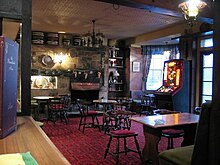
There was regulation of public drinking spaces in England from at least the 15th century. In 1496, under, Henry VII, an act was passed, "against vagabonds and beggers" (11 Hen. VII c2), that included a clause empowering two justices of the peace, "to rejecte and put awey comen ale-selling in tounes and places where they shall think convenyent, and to take suertie of the keepers of ale-houses in their gode behavyng by the discrecion of the seid justices, and in the same to be avysed and aggreed at the tyme of their sessions."[33]
The Beerhouse Act of 1830 is widely considered to be a milestone in the history of public houses. Gin was popularised in England in the late 17th century, largely because it provided an alternative to French brandy at a time of political and religious conflict between Britain and France.[34] Because of its cheapness, gin became popular with the poor, eventually leading to a period of drunkenness and lawlessness, known as the Gin Craze.[35][36]
In the early 19th century, encouraged by a reduction of duties, gin consumption again began to rise and gin houses and gin palaces (an evolution of gin shops) began to spread from London to most towns and cities in Britain. Alarmed at the prospect of a return to the Gin Craze, the government attempted to counter the threat, and encourage the consumption of a more wholesome beverage, by introducing the Beerhouse Act of 1830. The Act introduced a new lower, and largely deregulated, tier of premises called "the beerhouse".[37]

Under the act any householder, upon payment of two
Within eight years 46,000 new beerhouses opened[39] and, because operating costs were so low, huge profits were often made. The combination of increasing competition and high profits eventually led to what has been described as a golden age of pub building when many landlords extended or redeveloped their properties, adopting many features modern pubs still have.
Authorities attempted to check the growth from 1869 on by introducing magisterial control and new licensing laws. These aimed to make it harder to obtain a licence, and control drunkenness, prostitution, and other undesirable conduct on licensed premises.[40][41][42][43]
In the United Kingdom, restrictions were tightened considerably following the advent of the First World War.
Lock-in
A "lock-in" is when a pub owner allows patrons to continue drinking in the pub after the legal closing time, on the theory that once the doors are locked, it becomes a private party rather than a pub. Patrons may put money behind the bar before official closing time, and redeem their drinks during the lock-in so no drinks are technically sold after closing time. The origin of the British lock-in was a reaction to 1915 changes in the licensing laws in England and Wales, which curtailed opening hours to stop factory workers from turning up drunk and harming the war effort. From then until the start of the 21st century, UK licensing laws changed very little, retaining these comparatively early closing times. The tradition of the lock-in therefore remained. Since the implementation of the Licensing Act 2003, premises in England and Wales may apply to extend their opening hours beyond 11 pm, allowing round-the-clock drinking and removing much of the need for lock-ins.[48] Since the smoking ban, some establishments operated a lock-in during which the remaining patrons could smoke without repercussions but, unlike drinking lock-ins, allowing smoking in a pub was still a prosecutable offence.[49]
Smoking bans
Concerns about the effects of cigarette smoke inhalation first surfaced in the 1950s and ultimately led many countries to ban or restrict smoking in specific settings, such as pubs and restaurants. Early in 2004,
Some publicans raised concerns, prior to the implementation of restrictions, that a smoking ban would have a negative impact on sales.[52] The impact of the ban was mixed with some pubs suffering declining sales, and others seeing an increase, particularly in food sales.[53][54]
Architecture
Saloon or lounge
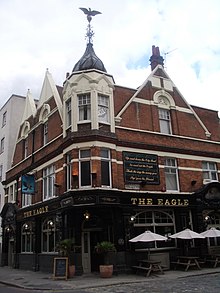
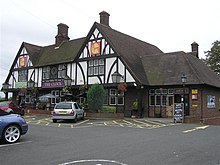
By the end of the 18th century, a new room in the pub was established: the saloon. Beer establishments had always provided entertainment of some sort—singing, gaming or sport. Balls Pond Road in Islington was named after an establishment run by a Mr. Ball that had a
A most famous London saloon was the Grecian Saloon in the Eagle,
A few pubs have stage performances such as serious drama, stand-up comedy, musical bands,
Public bar
The public bar, or tap room, was where the working class were expected to congregate and drink. It had unfurnished floorboards, sometimes covered with sawdust to absorb the spitting and spillages (known as "spit and sawdust"), bare bench seats and stools. Drinks were generally lower-quality beers and liquors.
This style was in marked contrast to the adjacent saloon or lounge bar which, by the early 20th century, was where male or accompanied female middle-class drinkers would drink. It had carpeted floors, upholstered seats, and a wider selection of better quality drinks that cost a penny or two more than those served in the public bar.
By the mid-20th century, the standard of the public bar had generally improved. Many were built between the world wars as part of the "improved" pub movement and as "roadhouse" inns—with large
Snug
The "snug" was a small private room or area, typically with access to the bar and a frosted glass window above head height. Customers in the snug paid a higher price for beer and nobody could look in and see the drinkers. Not only did wealthy visitors use these rooms, but also patrons who preferred not to be seen in the public bar. Ladies often enjoyed a private drink in the snug in a time when many frowned on women visiting a pub. The local police officer might nip in for a quiet pint, the parish priest for his evening whisky, or lovers for a rendezvous.
Campaign for Real Ale (CAMRA) have surveyed the 50,000 pubs in Britain and they believe that there are very few pubs that still have classic snugs. These are on a historic interiors list in order that they can be preserved.[63]
Counter
The pub took the concept of the bar counter to serve the beer from gin palaces in the 18th century.[64] Until that time beer establishments used to bring the beer out to the table or benches, as remains the practice in (for example) beer gardens and some other drinking establishments in Germany.[65] A bar might be provided for the manager or publican to do paperwork while keeping an eye on his or her customers, and the term "bar" applied to the publican's office where one was built,[66] but beer would be tapped directly from a cask or barrel sat on a table, or kept in a separate taproom and brought out in jugs.[67]
When purpose built Victorian pubs were built after the Beerhouse Act 1830,[68] the main room was the public room with a large serving bar copied from the gin houses, the idea being to serve the maximum number of people in the shortest possible time. The other, more private, rooms had no serving bar—they had the beer brought to them from the public bar. A number of pubs in the Midlands or the North still retain this set up, though now customers fetches the beer themselves from the taproom or public bar. One of these is the Vine, known locally as the Bull and Bladder, in Brierley Hill near Birmingham, another the Cock at Broom, Bedfordshire a series of small rooms served drinks and food by waiting staff.[69] By the early 1970s there was a tendency to change to one large drinking room as breweries were eager to invest in interior design and theming.[70]
Beer engine
A "beer engine" is a device for
The first beer pump known in England is believed to have been invented by John Lofting (born Netherlands 1659-d. Great Marlow Buckinghamshire 1742) an inventor, manufacturer and merchant of London.
The London Gazette of 17 March 1691 published a patent in favour of John Lofting for a fire engine, but remarked upon and recommended another invention of his, for a beer pump:
"Whereas their Majesties have been Graciously Pleased to grant Letters patent to John Lofting of London Merchant for a New Invented Engine for Extinguishing Fires which said Engine have found every great encouragement. The said Patentee hath also projected a Very Useful Engine for starting of beer and other liquors which will deliver from 20 to 30 barrels an hour which are completely fixed with Brass Joints and Screws at Reasonable Rates. Any Person that hath occasion for the said Engines may apply themselves to the Patentee at his house near St Thomas Apostle London or to Mr. Nicholas Wall at the Workshoppe near Saddlers Wells at Islington or to Mr. William Tillcar, Turner, his agent at his house in Woodtree next door to the Sun Tavern London."
"Their Majesties" referred to were
A further engine was invented in the late 18th century by the
Strictly the term refers to the pump itself, which is normally manually operated, though electrically powered and gas powered pumps are occasionally used.[73] When manually powered, the term "handpump" is often used to refer to both the pump and the associated handle.
Companies
This section needs additional citations for verification. (April 2017) |
In the 18th century, after the development of the large London
In the late 20th century, breweries increasingly ran their pubs directly, using managers rather than tenants. Most such breweries, such as the
Organisations such as
Pubs within a chain usually have items in common—such as fittings, promotions, ambience, and food and drink menu. A pub chain positions itself in the marketplace for a target audience. One company may run several pub chains aimed at different segments of the market. Pubs for use in a chain are bought and sold in large units, often from regional breweries that then close down. Newly acquired pubs are often renamed by the new owners, and many people resent the loss of
In 2009 about half of Britain's pubs were owned by large pub companies.[75]
Brewery tap
A brewery tap, also called a brewpub or taproom, is the nearest outlet for a brewery's beers. It is usually a room or bar in the brewery itself, although the name may be applied to a nearby pub.[citation needed]
Types
A pub has no strict definition, but
- Open to the public without membership / residency
- Serve draught beer or cider without requiring food be consumed
- Have at least one indoor area not laid out for meals
- Allow drinks to be bought at a bar (i.e. not only table service)
Together these characteristics differentiate pubs from restaurants and hotel bars, although some pubs also serve as restaurants or hotels.
Gastropub
A gastropub is a hybrid pub and
In 2011, The Good Food Guide suggested that the term has become irrelevant such is its commonality these days.[80]
Country pub

A "country pub" is simply a rural drinking establishment, though the term has acquired a romantic image typically of thatched roofs and whitewashed stone walls.[81] As with urban pubs, the country pub can function as a social and recreational centre, providing opportunities for people to meet, exchange news, and cooperate on local charitable events.[82] However, that culture of functioning as a social centre for a village and rural community started to diminish in the latter part of the 20th century, as many country pubs either closed down, or were converted to restaurants or gastropubs.[83] Those country pubs located on main routes may once have been coaching inns, providing accommodation or refreshment for travellers before the advent of motorised transport.[84]
Roadhouse
The term roadhouse was originally applied to a coaching inn, but with the advent of popular travel by
Theme pub
A theme pub is a pub that aligns itself to a specific culture, style or activity; often with the intention of attracting a niche clientele. Many are decorated and furnished accordingly, with the theme sometimes dictating the style of food or drink on offer too. Examples of theme pubs include sports bars,
Micropubs
In Britain, a micropub is a very small, modern, one-room pub founded on principles set up by Martyn Hillier, the creator of the first micropub, the Butchers Arms in Herne, Kent, in 2005.[86][87] Micropubs are "based upon good ale and lively banter",[88] commonly with a strong focus on local cask ale.[89] It became easier to start a small pub after the passing of the 2003 Licensing Act, which became effective in 2005.[87]
Other
A "nolo" or "no lo" pub serves only non-alcoholic and low-alcoholic beverages.[90][91][92] A temperance bar serves no alcohol at all.
Pub signs
In 1393, King
Another important factor was that during the
The earliest signs were often not painted but consisted, for example, of paraphernalia connected with the brewing process such as bunches of hops or brewing implements, which were suspended above the door of the pub. In some cases local nicknames, farming terms and puns were used. Local events were often commemorated in pub signs. Simple natural or religious symbols such as suns, stars and crosses were incorporated into pub signs, sometimes adapted to incorporate elements of the heraldry (e.g., the coat of arms) of the local lords who owned the lands upon which the pub stood. Some pubs have Latin inscriptions.
Other subjects that lent themselves to visual depiction included the name of battles (e.g.
Most British pubs still have decorated signs hanging over their doors, and these retain their original function of enabling the identification of the pub. Today's pub signs almost always bear the name of the pub, both in words and in pictorial representation. The more remote country pubs often have stand-alone signs directing potential customers to their door.
Names
Pub names are used to identify and differentiate each pub. Modern names are sometimes a marketing ploy or attempt to create "brand awareness", frequently using a comic theme thought to be memorable, Slug and Lettuce for a pub chain being an example. Interesting origins are not confined to old or traditional names, however. Names and their origins can be broken up into a relatively small number of categories.[95]
As many pubs are centuries old, many of their early customers were unable to read, and pictorial signs could be readily recognised when lettering and words could not be read.[96]
Pubs often have traditional names. A common name is the "Marquis of Granby". These pubs were named after
Some names for pubs that seem absurd or whimsical have come from corruptions of old slogans or phrases, such as the Bag o'Nails (Bacchanals), the Goat and Compasses (God Encompasseth Us),[99] the Cat and the Fiddle (Chaton Fidèle: Faithful Kitten) and the Bull and Bush, which purportedly celebrates the victory of Henry VIII at "Boulogne Bouche" or Boulogne-sur-Mer Harbour.[100][101]
Entertainment
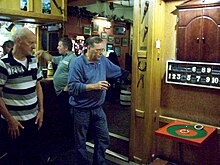
Traditional games are played in pubs, ranging from the well-known darts,
Increasingly, more modern games such as video games and slot machines are provided. Pubs hold special events, from tournaments of the aforementioned games to karaoke nights to pub quizzes. Some play pop music and hip-hop (dance bar), or show football and rugby union on big screen televisions (sports bar). Shove ha'penny[111] and Bat and trap[112] were also popular in pubs south of London.
Some pubs in the UK also have football teams composed of regular customers. Many of these teams are in leagues that play matches on Sundays, hence the term "
Pubs may be venues for
Food
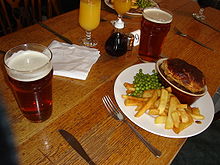
Some pubs have a long tradition of serving food, dating back to their historic usage as inns and hotels where travellers would stay.
Many pubs were drinking establishments, and little emphasis was placed on the serving of food, other than sandwiches and "
In the 1950s, some British pubs would offer "a pie and a pint", with hot individual steak and ale pies made easily on the premises by the proprietor's wife during the lunchtime opening hours.[113] The ploughman's lunch became popular in the late 1960s,[113] as did the convenient "chicken in a basket", a portion of roast chicken with chips, served on a napkin in a wicker basket.[113]
Family chain pubs that serve food in the evening gained popularity in the 1970s, and included Berni Inn and Beefeater.[113]
Quality dropped but variety increased with the introduction of
Some pubs offer elaborate hot and cold snacks free to customers at Sunday lunchtimes, to prevent them getting hungry and leaving for their lunch at home.Since the 1990s, food has become a more important part of a pub's trade, and today most pubs serve lunches and dinners at the table in addition to (or instead of) snacks consumed at the bar. They may have a separate dining room. Some pubs serve meals to a higher standard, to match good restaurant standards; these are sometimes termed gastropubs.
Listed
CAMRA maintains a "National Inventory" of historical notability and of architecturally and decoratively notable pubs.
Records


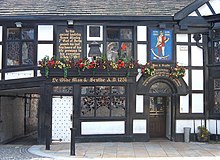
Highest and remotest
The highest pub in the United Kingdom is the Tan Hill Inn, North Yorkshire, at 1,732 feet (528 m) above sea level. The remotest pub on the British mainland is the Old Forge in the village of Inverie, Lochaber, Scotland. There is no road access and it may only be reached by an 18-mile (29 km) walk over mountains, or a 7-mile (11 km) sea crossing.[119]
Smallest
Contenders for the smallest public house in the UK include:[118]
- The Nutshell – Bury St Edmunds, Suffolk
- The Lakeside Inn – Southport, Merseyside
- The Little Gem – Aylesford, Kent
- The Smiths Arms – Godmanstone, Dorset
- The Signal Box Inn[120] – Cleethorpes, Lincolnshire
The list includes a small number of parlour pubs, one of which is the Sun Inn in Leintwardine, Herefordshire.
The smallest public house in Wales is claimed by Y Goron Fach (the Little Crown) in Denbigh, with a single bar of 15 square metres (160 sq ft).
Largest
The largest pub in the UK is the Royal Victoria Pavilion, in Ramsgate, Kent. The venue was previously a casino and before that a theatre.[121]
Oldest
A number of pubs claim to be the oldest surviving establishment in the United Kingdom, although in several cases original buildings have been demolished and replaced on the same site. Others are ancient buildings that were used for purposes other than as a pub previously in their history. Some notable claims include:
- Guinness World Record for the oldest pub in England for many years, as it is an 11th-century structure on an eighth-century site—however, the record was withdrawn in 2000 after review, and the category was deemed impossible to verify.[122]
- Ye Olde Trip to Jerusalem in Nottingham has been claimed to be the "oldest inn in England" with a founding date of 1189, but this relies on the fact it is constructed on the site of Nottingham Castle's former brewhouse; the present building actually dates from around 1650.[123]
- The Nags Head in Burntwood, Staffordshire, only dates back to the 16th century, but an (inaccurate) claim is still frequently made that a pub on the site was mentioned in the Domesday Book.[124]
- There is archaeological evidence that parts of the foundations of the Old Ferry Boat Inn in Holywell may date to AD 460, and there is evidence of ale being served as early as AD 560, but definitive dating evidence of the main building has yet to be established.[125]
- The Bingley Arms, Bardsey, Yorkshire, is claimed to date to 905 AD, but the current building only dates from the 18th century.
- Ye Olde Salutation Inn in Nottingham dates from 1240, although the building served as a tannery and a private residence before becoming an inn sometime before the English Civil War.
- The Adam and Eve in Norwich was first recorded in 1249, when it was an alehouse for the workers constructing nearby Norwich Cathedral.[126]
- Ye Olde Man & Scythe in Bolton, Greater Manchester, is mentioned by name in a charter of 1251, but the current building is dated 1631. Its cellars are the only surviving part of the older structure.
Longest and shortest name
The town of Stalybridge in Greater Manchester is thought to have the pubs with both the longest and shortest names in the United Kingdom – The Old Thirteenth Cheshire Astley Volunteer Rifleman Corps Inn and the Q Inn, both operating as of 2019[update] (the Rifleman reopening in new premises, moving from Astley Street to premises two doors away from the Q Inn in Market Street in 2019, after being closed for three years).[127][128] The original Rifleman building retains a pub sign, and a blue plaque from 1995 recording the recognition of the name in the Guinness Book of Records.[129]
Statistics
- The most expensive place to get a pint of beer is in Doha, Qatar, where prices average £10.30 (2019).[130]
- The average retail price of a pint of beer in the UK is £4.12 (2019).[130]
- The cheapest place to get a beer in the UK is Preston, where a pint costs on average £3.06 (2019).[130]
- In 2018, British people drank 7.75 billion pints of beer: 21.2 million pints a day.[131]
- As of 2019, there are 40,683 pubs in England, 2,901 in Wales and 3,612 in Scotland.[132]
- Pubs are closing at a rate of one every 12 hours (as of February 2019).[132]
Cultural associations
Inns and taverns feature throughout English literature and poetry, from

The highwayman
London
Many of London's pubs are known to have been used by famous people, but in some cases, such as the association between Samuel Johnson and Ye Olde Cheshire Cheese, this is speculative, based on little more than the fact that the person is known to have lived nearby. However, Charles Dickens is known to have visited the Cheshire Cheese, the Prospect of Whitby, Ye Olde Cock Tavern and many others. Samuel Pepys is also associated with the Prospect of Whitby and the Cock Tavern.
The
The
In 1966
Oxford and Cambridge
Outside Great Britain

Although "British" pubs found outside of Britain and its former colonies are often themed bars owing little to the original British pub, a number of "true" pubs may be found around the world.

In Scandinavia, especially Denmark, a number of pubs that eschew "theming" have opened. They instead focus on providing carefully conditioned beer, often independent of any particular brewery or chain, in an environment not unfamiliar to a British pub-goer. Some import British cask ale, rather than beer in kegs, to provide the full British real ale experience to their customers. This newly established Danish interest in British cask beer and the British pub tradition is reflected by the fact that some 56 British cask beers were available at the 2008 European Beer Festival in Copenhagen, which was attended by more than 20,000 people.
In Ireland, pubs are known for their atmosphere or "craic".[148] In Irish, a pub is referred to as teach tábhairne ("tavernhouse") or teach óil ("drinkinghouse"). Live music, either sessions of traditional Irish music or varieties of modern popular music, is frequently featured in the pubs of Ireland. Pubs in Northern Ireland are largely identical to their counterparts in the Republic of Ireland except for the lack of spirit grocers. A side effect of the Troubles was that the lack of a tourist industry meant that a higher proportion of traditional bars have survived the wholesale refitting of Irish pub interiors in the "English style" in the 1950s and 1960s. New Zealand sports a number of Irish pubs.[149]
Pubs have a long history in Canada, with some still operating after 200 years, like
In South Africa pubs and taverns have had a particularly long and notable presence in the city of Cape Town. Prior to the opening of the Suez Canal in 1869, Cape Town was a major trading port between Europe and Asia and hosted a very large number of drinking establishments earning the city the moniker Tavern of the Seas.[150][151] The oldest currently operating pub in South Africa, and one of the last drinking establishments left from the Tavern of the Seas era, is the Perseverance Tavern opened in 1808.[152]
In fiction
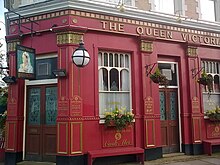
Pubs are a common setting for fictional works, including novels, stories, films, video games, and other works. In many cases, authors and other creators develop imaginary pubs for their works, some of which have become notable fictional places. Notable fictional pubs include The Admiral Benbow Inn in the
The major
See also
- Tavern
- Bar
- Flat-roofed pub
- Campaign for Real Ale
- Pub crawl
- SpåraKoff
- Public houses in Ireland
- Public houses in Australia
- List of award-winning pubs in London
- List of microbreweries
- List of public house topics
- List of public houses in Australia
- Alcohol licensing laws of the United Kingdom
- Alcohol licensing laws of Ireland
References
- ^ Cooper, Stephen. "Origins of the English pub" (PDF). chivalryandwar.co.uk.
- ^ ISBN 978-1-84781-654-2.
- ^ "History of the pub". Beer and Pub Association. Archived from the original on 13 July 2010.
- ^ a b "Great British Pub". Archived from the original on 14 February 2012.
- ^ "Public House". Encyclopædia Britannica. 22 July 2021.
- ISBN 978-1-873150-53-5. Retrieved 27 March 2011.
- ^ Australian Drinking Culture Archived 9 November 2020 at the Wayback Machine Convict Creations. Retrieved 24 April 2011.
- ^ "Editorial | In praise of ... pubs". The Guardian. 10 December 2016. Archived from the original on 21 December 2016.
- ISBN 9781911127017.
- ISBN 9780198217169.
- ^ "Company History". Innholders Company. Archived from the original on 19 March 2022. Retrieved 2 July 2019.
- ^ Monckton, Herbert Anthony (1966), A History of English Ale and Beer, Bodley Head (p. 101)
- ISBN 9780199655786.
- ^ "8 Ways Roads Helped Rome Rule the Ancient World". HISTORY.com. 29 August 2018. Archived from the original on 24 December 2019. Retrieved 3 February 2020.
- ^ Pub Rooms, pub accommodation Archived 28 January 2016 at the Wayback Machine.
- ^ "How did historic alehouses taverns and inns evolve into the pubs we see today?". Morning Advertiser. 5 March 2019.
- ^ "The Oxford Companion to Beer definition of public houses (pubs)". Craft Beer and Brewing.
- ISBN 9-780709-056942.
- ^ "Greene King". Staff handbook.
- ^ "The Tied House System". Craft Beer and Brewing.
- ^ "House of Commons Select Committee on Trade and Industry report". Parliament of the United Kingdom. Archived from the original on 6 August 2020. Retrieved 29 April 2020.
- ISBN 9780230298576.)
{{cite book}}: CS1 maint: multiple names: authors list (link - ^ British Beer and Pub Association – Statistics, "UK Beer Market". Archived from the original on 24 November 2014. Retrieved 24 November 2014.
- ^ "4000 pubs stuck in the 1980s". 29 August 2013. Archived from the original on 16 October 2015. Retrieved 1 May 2015.
- ^ "Last orders for struggling Welsh pubs". BBC. 28 August 2010. Archived from the original on 16 October 2015. Retrieved 1 May 2015.
- ^ "Why are British pubs closing down? (video)". BBC. 6 March 2015. Archived from the original on 22 May 2015. Retrieved 1 May 2015.
- ^ "Pub companies, pub tenants & pub closures: recent developments – Commons Library Standard Note". Archived from the original on 27 February 2015. Retrieved 1 May 2015.
- ^ "The Lost Pubs Project". Retrieved 9 August 2023.
- ^ "Why London's pubs are disappearing". The Economist. 24 August 2017. Archived from the original on 25 August 2017. Retrieved 25 August 2017.
- ^ "Pub numbers fall to lowest on record". BBC News. 4 July 2022. Retrieved 5 July 2022.
- ^ "Pub numbers fall to lowest on record". BBC News. 3 July 2022. Retrieved 9 August 2023.
- ^ Slow, Oliver (18 September 2023). "Two pubs a day disappearing in England and Wales". BBC News. Retrieved 18 September 2023.
- ^ The National Cyclopaedia of Useful Knowledge, Vol 1, London, Charles Knight, 1847, pp. 410–1.
- ^ Phillips, Roderick (2014). Alcohol A History. The University of North Carolina Press.
- ^ "Gin Renaissance in City of London". Farmers & Fletcher. Archived from the original on 12 September 2018. Retrieved 27 April 2020.
- ^ "William Hogarth, Gin Lane, etching and engraving". British Museum – via Google Arts & Culture.
- ^ "Beer Houses". AMLWCH History. Archived from the original on 17 December 2007.
- ^ "Beer Houses". History UK. Archived from the original on 19 May 2009.
- ^ "Beer houses". Old Cannon Brewery. Archived from the original on 10 January 2007.
- ^ "'The vices and virtue of drink (17th–18th centuries)'- news :: You Are What You Ate". University of Leeds. Archived from the original on 16 March 2017. Retrieved 16 March 2017.
- from the original on 16 March 2017.
- ^ "Tavern regulation debate – Module Forum: The World of the Tavern (HI390)". University of Warwick. Archived from the original on 16 March 2017. Retrieved 16 March 2017.
- ^ Archives, The National. "The National Archives – Homepage". The National Archives. Retrieved 18 November 2019.
- ^ "Defence of the Realm Act". Spartacus.schoolnet.co.uk. Archived from the original on 3 April 2009. Retrieved 26 June 2009.
- ^ "Awards by the Pembrokeshire Authority". Western Mail. British Newspaper Archive. 28 September 1914. Retrieved 10 August 2015.
- ^ "Licensing – A Brief History". Archived from the original on 23 September 2015. Retrieved 10 August 2015.
- ISBN 978-1-904147-30-5. Archivedfrom the original on 2 January 2008.
- ^ "R.I.P. Lock-ins". BBC News. London. 23 November 2005. Archived from the original on 4 June 2009. Retrieved 21 July 2009.
- ^ Keegan, Mike (9 June 2008). "'Smoking lock-ins' flaunt ban". Manchester Evening News. Archived from the original on 21 April 2013. Retrieved 4 November 2012.
- ^ Langton, David (1 December 2006). "Ban on smoking in pubs to come into force on 1 July". The Independent. London. Archived from the original on 28 May 2009. Retrieved 10 July 2008.
- ^ Kelsey, Rick (1 June 2015). "Smoking bans: How they vary around the world". The BBC. online. Retrieved 29 May 2021.
- ^ Lusher, Adam; Goslett, Miles (3 June 2007). "Hundreds of pubs to flout smoking ban". The Daily Telegraph. London. Archived from the original on 13 July 2009. Retrieved 21 July 2009.
- ^ "Smoking out the truth on the ban – two years on". The Publican. Archived from the original on 17 July 2011. Retrieved 21 July 2009.
- ^ "UPDATE 3-Wetherspoon sees FY profit at top end of forecasts". Reuters. 15 July 2009. Archived from the original on 18 July 2009. Retrieved 21 July 2009.
- ^ a b "Pop Goes the Weasel". Nursery Rhymes Lyrics and Origins. Retrieved 23 July 2019.
- ^ SilkTork. "Time Gentlemen Please!". Archived from the original on 28 January 2013. Retrieved 12 May 2013.
- ^ a b David Kemp (1992) The pleasures and treasures of Britain: a discerning traveller's companion p.158. Dundurn Press Ltd., 1992
- ^ "Time Gentlemen Please!". Ratebeer.com. Archived from the original on 20 February 2009. Retrieved 26 June 2009.
- ^ "Oxford dictionaries: spit and sawdust". Archived from the original on 22 July 2015. Retrieved 30 April 2015.
- ^ Rodrigues, Jason (15 November 2012). "30 years ago: El Vino's treatment of women drinkers ruled unlawful". The Guardian.
- ^ Kerley, Paul (28 August 2015). "Are these England's most beautiful pubs?". BBC News Magazine. Archived from the original on 29 August 2015.
- ^ Fox, Kate (1996) Passport to the Pub: tourist's guide to pub etiquette "SIRC - Passport to the Pub Chapter 1". Archived from the original on 10 May 2010. Retrieved 25 February 2010.
- ^ Derbyshire – Spondon, Malt Shovel Archived 21 August 2014 at the Wayback Machine, Heritagepubs, CAMRA. Retrieved 27 August 2014.
- ^ Mellows, Phil (5 March 2019). "How-did-historic-alehouses-taverns-and-inns-evolve-into-the-pubs-we-see-today". morningadvertiser.co.uk.
- ISBN 1-85074-906-X. Retrieved 15 October 2010.
- ISBN 9781317209171.
- ^ Brandwood, Geoff. "The vanishing faces of the traditional pub" (PDF). breweryhistory.com.
- ^ Collins, Nick (28 January 2011). "The rise and fall of the British pub". The Daily Telegraph.
- ^ "The Cock at Broom – 01767 314411 One of England's Real Heritage Pubs". thecockatbroom.co.uk. Archived from the original on 16 May 2015.
- ^ Evans, David G., et al. (1975) The Manchester Pub Guide, Manchester and Salford City Centres. Manchester: Manchester Pub Surveys; pp. 1–4
- ^ "Time Gentlemen Please!". ratebeer.com. Archived from the original on 6 February 2010. Retrieved 15 October 2010.
- ISBN 978-1-905633-05-0. Retrieved 15 October 2010.
- ^ "In the Pub". CAMRA. Archived from the original on 20 April 2011. Retrieved 26 June 2009.
- ^ "The Supply of Beer nationalarchives.gov.uk". Archived from the original on 10 April 2004. Retrieved 9 March 2015.
- ^ "Pubs 'face mass closure threat'". BBC. 27 January 2009. Retrieved 1 May 2015.
- ^ Farley, David (24 May 2009). "New York Develops a Taste for Gastropubs". The Washington Post.
- ^ Norrington-Davies, Tom (24 November 2005). "Is the gastropub making a meal of it?". The Daily Telegraph. London. Retrieved 10 July 2008.[dead link]
- ^ "American gastropub: what's in a name?". Art Culinaire. via findarticles.com. Spring 2007. Archived from the original on 3 March 2008. Retrieved 23 July 2008.
- ^ Norrington-Davies, Tom (24 November 2005). "Is the gastropub making a meal of it? – Telegraph". The Daily Telegraph. London. Archived from the original on 1 June 2009. Retrieved 21 July 2009.
- ^ "Gastropub RIP". The Good Food Guide. 4 September 2011. Archived from the original on 17 May 2013. Retrieved 22 July 2013.
- ISBN 9781911127017.
- ISBN 9780215545510.
- ^ The more recent developments of the country pub Archived 20 November 2008 at the Wayback Machine
- ^ "The Country Pub". Southern Life (UK). Archived from the original on 12 October 2008.
{{cite web}}: CS1 maint: unfit URL (link) - ^ Gutzke, David W (2005). "Improved Pubs and Road Houses: Rivals for Public Affection in Interwar England". breweryhistory.com. The Brewery History Society. Retrieved 3 April 2016.
- ^ Hailstone, Jamie (11 June 2015). "Small is beautiful – the quiet rise of the micropub". Morning Advertiser.
- ^ a b Hawkes, Will (17 February 2011). "A local pub for local people: 'Micropubs' are catching on". The Independent. Archived from the original on 2 October 2016. Retrieved 9 November 2012.
- ^ "Micropub Assoc – The Butcher's Arms". micropub.co.uk. Archived from the original on 12 June 2020. Retrieved 24 April 2020.
- ^ "Community fixers? The mighty rise of the micropub". New Statesman. Archived from the original on 3 July 2015.
- ^ Gray, Daniella (25 July 2019). "Sainsbury's Launches First 'NoLo' Pub". Health & Wellbeing.
- ^ Farrah, Sophie (17 July 2019). "The new trend NOLO comes to Hampton". Essential Surrey & SW London.
- ^ "Shaman is a low-alcohol bar in London for healthy hedonism". Globetrender. 13 March 2020.
- ^ "QI: some quite interesting facts about pubs". The Telegraph. 10 December 2016. Archived from the original on 12 April 2018.
- ^ Video of artist Michael Farrar-Bell producing inn signs from British Pathe News
- ^ "The History Press | A history of British pub names". www.thehistorypress.co.uk. Retrieved 27 August 2019.
- ^ "Culture UK – Pub and Inn Signs". Historic-uk.com. Archived from the original on 8 February 2012. Retrieved 4 November 2012.
- ISSN 0307-1235. Retrieved 27 August 2019.
- ^ "Royal George, Cottingham". whatpub.com. Retrieved 27 August 2019.
- ^ Brewer, E. Cobham (1989), Brewer's Dictionary of Phrase and Fable; 14th edn, by Ivor H. Evans. London: Cassell; p. 482, where it is thought unlikely, and two other suggestions are given.
- ^ Brewer, E. Cobham (1898). "Dictionary of Phrase and Fable". Archived from the original on 15 June 2008. Retrieved 17 October 2008.
- ^
Dictionary of Pub Names – Google Books. Wordsworth Editions. 10 September 2006. ISBN 978-1-84022-266-1. Retrieved 31 August 2009.
- ^ Masters, James. "The History of Darts and other Useful Information". Tradgames.org.uk. Archived from the original on 14 June 2009. Retrieved 26 June 2009.
- ^ Masters, James. "Skittles, Nine Pins – Online guide". Tradgames.org.uk. Archived from the original on 2 June 2009. Retrieved 26 June 2009.
- ^ Masters, James. "Dominoes – Online Guide". Tradgames.org.uk. Archived from the original on 14 June 2009. Retrieved 26 June 2009.
- ^ Masters, James (21 February 1936). "Bar Billiards – Online Guide". Tradgames.org.uk. Archived from the original on 28 June 2009. Retrieved 26 June 2009.
- ^ Masters, James. "Aunt Sally – The Online Guide". Tradgames.org.uk. Archived from the original on 15 June 2009. Retrieved 26 June 2009.
- ^ Masters, James. "Nine Mens Morris, Mill – Online guide". Tradgames.org.uk. Archived from the original on 18 June 2009. Retrieved 26 June 2009.
- ^ Masters, James. "Ringing the Bull – History and information". Tradgames.org.uk. Archived from the original on 18 June 2009. Retrieved 26 June 2009.
- ^ Masters, James. "History of Pool and Carom Billiards – Online Guide". Tradgames.org.uk. Archived from the original on 28 June 2009. Retrieved 26 June 2009.
- ^ Masters, James. "Billiards and Snooker – Online guide". Tradgames.org.uk. Archived from the original on 2 July 2009. Retrieved 26 June 2009.
- ^ Masters, James. "Shove Ha'penny – Online Guide". Tradgames.org.uk. Archived from the original on 15 June 2009. Retrieved 26 June 2009.
- ^ Masters, James. "Bat and Ball Games – Online Guide". Tradgames.org.uk. Archived from the original on 3 March 2009. Retrieved 26 June 2009.
- ^ a b c d e "Nostalgia: Latest Nostalgia pieces from Gazette Live". Rememberwhen.gazettelive.co.uk. Archived from the original on 28 March 2014. Retrieved 9 March 2015.
- ^ Barry, Tina (29 April 2005). "Better Pub Grub". The Brooklyn Paper. Archived from the original on 12 May 2013. Retrieved 22 July 2013.
- ^ "Pub grub gets out of pickle". The Mirror. 27 June 2005. Archived from the original on 25 May 2014. Retrieved 22 July 2013.
- ^ "CAMRA National Inventory". 19 February 2012. Archived from the original on 19 February 2012. Retrieved 9 March 2015.
- ^ Trinder-Widdess, Zoe. "National Trust Website". Nationaltrust.org.uk. Archived from the original on 23 May 2006. Retrieved 26 June 2009.
- ^ ISBN 1-85249-198-1
- ^ "The Old Forge". The Old Forge. Archived from the original on 14 August 2010. Retrieved 7 July 2010.
- ^ John White of White Beer Travels. "Signal Box Inn". Whitebeertravels.co.uk. Archived from the original on 6 March 2012. Retrieved 4 November 2012.
- ^ Historic England. "Royal Victoria Pavilion (1336672)". National Heritage List for England. Retrieved 7 December 2019.
- ^ Guy, Jack (7 February 2022). "After more than 1,000 years, this English pub is closing its doors". CNN. Retrieved 7 February 2022.
- ^ "The Legend of Ye Olde Trip To Jerusalem". Ye Olde Trip to Jerusalem. Archived from the original on 16 October 2009. Retrieved 24 June 2010.
- ^ "Domesday book". Retrieved 18 April 2019.[permanent dead link]
- ^ "Oldest Inn in Britain". fatbadgers.co.uk. Archived from the original on 19 August 2009. Retrieved 29 August 2009.
- ^ Sargent, Peter. "Adam and Eve pub Bishopgate, Norwich". Eastern Daily Press. Archived from the original on 19 October 2010.
- ^ Wolfe-Robinson, Maya (16 July 2019). "Pub with longest name in UK reopens next to pub with shortest". The Guardian.
- ^ Yarwood, Sam (15 July 2019). "Pub with longest name in the country reopens in Tameside – two doors down from the pub with the shortest – Manchester Evening News". Manchester Evening News.
- ^ "Blue Plaque – The Rifleman Inn". Tameside Metropolitan Borough. Retrieved 16 July 2019.
- ^ a b c Johnson, Georgia-Rose (31 July 2019). "The average price of a pint in 150+ countries | interactive world map". Finder UK. Retrieved 14 October 2019.
- ^ "25th July 2018". British Beer and Pub Association. Archived from the original on 14 October 2019. Retrieved 14 October 2019.
- ^ ISSN 0307-1235. Retrieved 14 October 2019.
- ^ Shelley, Henry C. (Henry Charles). "Inns and Taverns of Old London". infomotions.com. Archived from the original on 17 February 2012. Retrieved 21 July 2009.
- ^ Highwaymen, Historic UK, archived from the original on 5 February 2012, retrieved 13 May 2012
- ^ Paschke, Jean (March 2007). "The Cornwall of Daphne du Maurier". britishheritage.com. British Heritage Society. Archived from the original on 2 March 2016. Retrieved 3 April 2016.
- ^ My Three Inns, 1949, includes those he kept in Ascot and Market Harborough. There are more recent editions of the diary.
- ^ Milmo, Cahal (22 November 2003). "An 'authentic' day out: fish and chips at the Dun Cow, for a very reasonable £1m – This Britain, UK". The Independent. London. Retrieved 21 July 2009.[dead link]
- ^ "British Beer and Pub Association". Beerandpub.com. Archived from the original on 26 July 2009. Retrieved 22 July 2009.
- ^ Alleyne, Richard (10 April 2008). "Low sales force four village pubs to close a day – Telegraph". The Daily Telegraph. London. Archived from the original on 2 December 2008. Retrieved 22 July 2009.
- ^ Fitzroy Tavern, Fitzrovia, London W1T 2NA Archived 30 September 2010 at the Wayback Machine.
- ^ Lloyd-Jones, Nick (4 May 2005). "Westminster: For whom the division bell tolls". The Independent. London. Archived from the original on 2 June 2013.
- ^ Gammell, Caroline & Singh, Anita (20 November 2009). "Madonna and Guy Ritchie reach divorce settlement". The Daily Telegraph. London. Archived from the original on 5 May 2013. Retrieved 17 December 2009.
- ^ "BBC ON THIS DAY | 1969: Kray twins guilty of McVitie murder". BBC News. 4 March 1976. Archived from the original on 27 December 2007. Retrieved 9 March 2015.
- ^ "The Magdala" Archived 31 March 2009 at the Wayback Machine FancyaPint.com (Retrieved 13 February 2010)
- ^ "Lenin and Stalin met here". Shady Old Lady's Guide to London. Archived from the original on 9 March 2012. Retrieved 13 May 2012.
- ISBN 0-19-538341-9; p. 52
- ^ Noble, Ivan (27 February 2003). "'Secret of life' discovery turns 50". BBC. Archived from the original on 9 September 2010.
- ^ "What's the Craic?". Edgehill.ac.uk. Archived from the original on 17 April 2008. Retrieved 26 June 2009.
- ^ "Consulate General of Ireland: Bars and pubs". Archived from the original on 9 October 2013. Retrieved 27 May 2015.
- ^ ""Tavern of the Seas"? The Cape of Good Hope as an oceanic crossroads during the seventeenth and eighteenth centuries". webdoc.sub.gwdg.de. Retrieved 3 March 2021.
- S2CID 161911784.
- ^ Williams, Murray (22 July 2020). "Oldest pub in SA 'The Percy' shuts up shop as lockdown takes its toll". News24. Retrieved 29 July 2020.
- ^ Soap box or soft soap? audience attitudes to the British soap opera Archived 3 September 2009 at the Wayback Machine; by Andrea Millwood Hargrave with Lucy Gatfield, May 2002, Broadcasting Standards Commission; p. 20. Retrieved 21 July 2009.
- ^ Hardman, Robert (9 December 2000). "Coronation treat for Prince at the Rovers – Telegraph". The Daily Telegraph. London. Archived from the original on 12 November 2012. Retrieved 21 July 2009.
- ^ "EastEnders queens resolve royal issue". BBC News. London. 23 November 2001. Retrieved 21 July 2009.
Bibliography
- Christy, Miller (1887). "Trade Signs of Essex: a popular account of the origin and meanings of the public house and other signs now or formerly found in the county of Essex". Chelmsford: Edmund Durrant & Co. Archived from the original on 20 February 2012. Retrieved 13 March 2009.
- Cornell, Martyn (2003). Beer: the story of the pint. London: Headline. ISBN 978-0-7553-1165-1.
- Haydon, Peter (2001). Beer and Britannia: an inebriated history of Britain. Stroud: Sutton. ISBN 978-0-7509-2748-2.
- Jackson, Michael & Smyth, Frank (1976). The English Pub. London: Collins. ISBN 0-00-216210-5.
- www.breweryartists.co.uk A history of the Brewery Artists Inn Sign studio
Further reading
- Kelner, Simon (7 August 2019). "Pubs can be bizarre and peculiar, but they're worth saving as a focal point of a community". i News.
- Burke, Thomas (1927). The Book of the Inn: being two hundred pictures of the English inn from the earliest times to the coming of the railway hotel; selected and edited by Thomas Burke. London: Constable.
- Burke, Thomas (1930). The English Inn. (English Heritage.) London: Herbert Jenkins.
- Burke, Thomas (1947). The English Inn (Revised ed.). (The Country Books.) London: Herbert Jenkins.
- Clark, Peter (1983). The English Alehouse: a social history, 1200–1830. Harlow: Longman. ISBN 0-582-50835-5.
- Clark, Peter (1978). "The Alehouse and the Alternative Society", in: Puritans and Revolutionaries: essays in seventeenth-century history presented to Christopher Hill; ed. D. H. Pennington & Keith Thomas. Oxford: Clarendon Press, 1978; pp. 47–72.
- Douch, H. L. (1966). Old Cornish Inns and their place in the social history of the County. Truro: D. Bradford Barton.
- Everitt, Alan. "The English Urban Inn 1560–1760." Perspectives in English urban history (Palgrave Macmillan UK, 1973) pp. 91–137. (The Oxford Companion to Local and Family History (ed. David Hey), 1996, describes this as "the starting point for modern studies [of inns]"; Everitt described most of the previous literature on the topic as "a wretched farrago of romantic legends, facetious humour and irritating errors".)
- Gutzke, David W. Pubs and Progressives: Reinventing the Public House in England, 1896–1960(Northern Illinois University Press, 2006).
- Hackwood, Frederick W. (1910). Inns, Ales and Drinking Customs of Old England. London: T. Fisher Unwin.
- Reissued: London: Bracken Books, 1985. ISBN 0-946495-25-4.
- Reissued: London: Bracken Books, 1985.
- Hailwood, Mark. Alehouses and Good Fellowship in Early Modern England (Boydell & Brewer Ltd, 2014).
- Jennings, Paul. A History of Drink and the English, 1500–2000 (Routledge, 2016).
- Jennings, Paul. "Liquor Licensing and the Local Historian: The Victorian Public House." Local Historian 41 (2011): 121–137.
- Martin, John (1993). Stanley Chew's Pub Signs: a celebration of the art and heritage of British pub signs. Worcester: John Martin. ISBN 1-85421-225-7.
- Monson-Fitzjohn, G. J. (1926) Quaint Signs of Olde Inns. London: Herbert Jenkins (reissued by Senate, London, 1994 ISBN 1-85958-028-9).
- Mutch, Alistair. "Improving the public house in Britain, 1920–40: Sir Sydney Nevile and 'social work'." Business history 52.4 (2010): 517–535.
- Nicholls, James. "Alcohol licensing in Scotland: a historical overview." Addiction 107.8 (2012): 1397–1403.
- Richardson, A. E. (1934). The Old Inns of England. London: B. T. Batsford.
External links
- Pubs at Curlie
- Lost Pubs Project – archive of closed English pubs
- . Encyclopædia Britannica (11th ed.). 1911.

